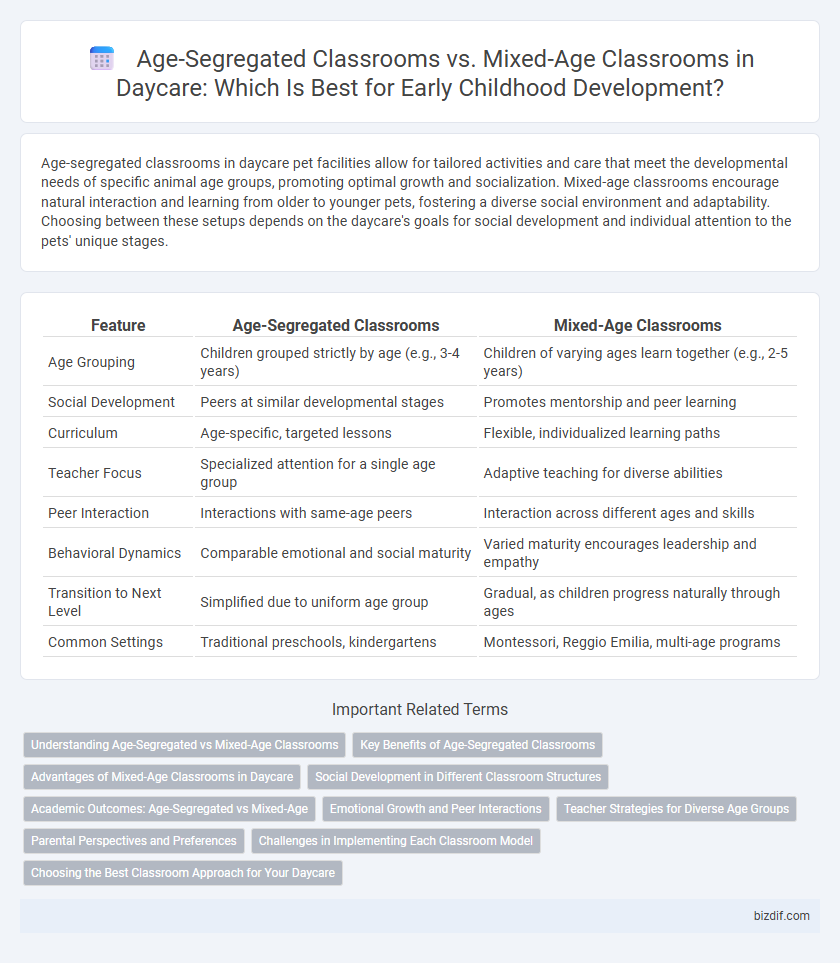Age-segregated classrooms in daycare pet facilities allow for tailored activities and care that meet the developmental needs of specific animal age groups, promoting optimal growth and socialization. Mixed-age classrooms encourage natural interaction and learning from older to younger pets, fostering a diverse social environment and adaptability. Choosing between these setups depends on the daycare's goals for social development and individual attention to the pets' unique stages.
Table of Comparison
| Feature | Age-Segregated Classrooms | Mixed-Age Classrooms |
|---|---|---|
| Age Grouping | Children grouped strictly by age (e.g., 3-4 years) | Children of varying ages learn together (e.g., 2-5 years) |
| Social Development | Peers at similar developmental stages | Promotes mentorship and peer learning |
| Curriculum | Age-specific, targeted lessons | Flexible, individualized learning paths |
| Teacher Focus | Specialized attention for a single age group | Adaptive teaching for diverse abilities |
| Peer Interaction | Interactions with same-age peers | Interaction across different ages and skills |
| Behavioral Dynamics | Comparable emotional and social maturity | Varied maturity encourages leadership and empathy |
| Transition to Next Level | Simplified due to uniform age group | Gradual, as children progress naturally through ages |
| Common Settings | Traditional preschools, kindergartens | Montessori, Reggio Emilia, multi-age programs |
Understanding Age-Segregated vs Mixed-Age Classrooms
Age-segregated classrooms group children by specific age ranges, allowing tailored educational activities that match developmental stages and milestones for better cognitive and social growth. Mixed-age classrooms encourage peer learning and mentorship, where older children reinforce their skills by helping younger peers, promoting collaboration and empathy. Both models impact social development and learning effectiveness differently, making it essential for daycare centers to align classroom structures with their educational goals and resources.
Key Benefits of Age-Segregated Classrooms
Age-segregated classrooms in daycare settings provide targeted developmental activities tailored to specific age groups, enhancing cognitive and social growth. These classrooms allow educators to focus on age-appropriate milestones and create a structured learning environment that supports consistent progress. Research shows that age segregation fosters peer bonding and reduces behavioral challenges commonly found in mixed-age groups.
Advantages of Mixed-Age Classrooms in Daycare
Mixed-age classrooms in daycare foster social development by encouraging older children to mentor younger peers, enhancing communication and leadership skills. These settings promote individualized learning, allowing children to progress at their own pace while benefiting from diverse interactions. Research highlights improved problem-solving abilities and greater emotional resilience in children attending mixed-age classrooms compared to age-segregated groups.
Social Development in Different Classroom Structures
Age-segregated classrooms in daycare settings promote targeted social development by grouping children with similar cognitive and emotional stages, facilitating age-appropriate interactions and peer bonding. Mixed-age classrooms encourage mentorship and empathy, as older children model social behaviors and assist younger peers, fostering a collaborative learning environment. Both structures influence social skills differently, with age-segregated classrooms emphasizing peer homogeneity and mixed-age settings enhancing diversity in social experiences.
Academic Outcomes: Age-Segregated vs Mixed-Age
Age-segregated classrooms often promote targeted curriculum development tailored to specific developmental stages, resulting in measurable academic gains in literacy and numeracy. Mixed-age classrooms encourage peer learning and mentorship, fostering critical thinking and social-emotional skills that indirectly enhance academic performance. Studies indicate that while age-segregated settings excel in standardized test scores, mixed-age environments improve adaptive learning and long-term academic resilience.
Emotional Growth and Peer Interactions
Age-segregated classrooms foster emotional growth by providing children with peers at similar developmental stages, which supports age-appropriate emotional understanding and regulation. Mixed-age classrooms enhance peer interactions by encouraging mentorship, empathy, and cooperative learning among children of different ages, promoting diverse social skills. Both settings uniquely contribute to emotional development, with age-segregated groups emphasizing tailored emotional support and mixed-age settings fostering dynamic social bonds.
Teacher Strategies for Diverse Age Groups
Effective teacher strategies in age-segregated classrooms include tailored curriculum design and age-appropriate activities that meet developmental milestones. In mixed-age classrooms, educators implement differentiated instruction and peer learning opportunities to foster collaboration and individualized growth. Both approaches require adaptive behavior management techniques to address varied cognitive and social needs within the classroom environment.
Parental Perspectives and Preferences
Parents often prefer age-segregated classrooms in daycare settings because they believe children benefit from age-appropriate curriculum and social interactions that match developmental milestones. Some parents favor mixed-age classrooms for fostering peer learning, empathy, and leadership skills among children of different ages. Parental preferences typically reflect priorities for tailored educational experiences or social development opportunities within daycare environments.
Challenges in Implementing Each Classroom Model
Age-segregated classrooms in daycare settings present challenges such as rigid curriculum planning tailored to narrow developmental stages and limited peer learning opportunities. Mixed-age classrooms face difficulties including managing diverse skill levels, balancing individual needs, and requiring teachers to implement differentiated instruction effectively. Both models demand specialized staff training and resource allocation to address the unique social and cognitive demands of their age group compositions.
Choosing the Best Classroom Approach for Your Daycare
Age-segregated classrooms in daycare settings promote developmentally appropriate activities tailored to specific age groups, enhancing targeted learning outcomes and social interactions among peers. Mixed-age classrooms foster mentorship opportunities, adaptability, and empathy as younger children learn from older peers while older children reinforce their knowledge by teaching. Choosing the best classroom approach depends on your daycare's educational philosophy, staff expertise, and the needs of your children and families.
Age-segregated classrooms vs mixed-age classrooms Infographic

 bizdif.com
bizdif.com